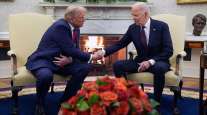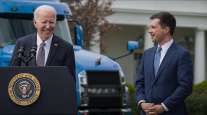Senior Reporter
Experts: Public-Private Partnerships Could Plug Federal Government Shortfalls in Infrastructure Funding

WASHINGTON — As Congress looks to find common ground on a $2 trillion proposal that would ensure long-term infrastructure funding on the federal level, states could look more to public-private partnerships as a means of paying for local projects, experts said.
“The federal government owns about 10% of our country’s infrastructure, and we fund currently about 14% of total infrastructure funding,” said Dan DeBono, chief infrastructure funding officer for the U.S. Department of Transportation, during a two-day P3 Policy and Delivery Summit held in conjunction with Infrastructure Week. “We’d like to see that ratio shift back more to the states and localities. We think that giving the decision-making power back to local communities makes a lot of sense.”
In fact, DeBono said there is a “pretty low chance” of future local projects being funded by the federal government.
“The Department of Transportation fully supports public-private partnerships,” he said during the May 15 session. “We don’t think the numbers work in the absence of those mechanisms.”
Although some states have in effect outlawed P3s for transportation projects, DeBono suggested they could play a role in empowering decision-making at the state and local level.
“The reason we like public-private partnerships is that we think they increase certainty of completion, increase cost control and the general maximization of best practices trump any other consideration,” DeBono said. “The key is being able to articulate to voters that risk is being transferred to the private sector.”
Currently, P3s are being used for projects ranging from hurricane recovery in Puerto Rico to a $12 billion redevelopment project in a terminal at New York’s John F. Kennedy International Airport, panelists said. P3 road projects have ranged from building 29 miles of high-occupancy toll lanes to add capacity and introduce congestion pricing on the heavily traveled Interstate 95 corridor in Virginia to projects in Pennsylvania to improve bridges, support motorist safety, and, in some cases, generate new revenue to support future investment.

Poole
Robert Poole, director of transportation policy at Reason Foundation, said that he believes P3s could 10 years from now be used to fund bridge-replacement projects on interstates. He also sees a future where long-distance dedicated truck lanes will be used by platoons of three-to-six trucks. “Once you have dedicated truck lanes, you can run doubles and triples to increase productivity,” Poole said.
But Morteza Farajian, former director of the Virginia P3 office, said that government officials may find it difficult to sell the public on using P3s for large projects.
“Sometimes the project makes sense, and sometimes it doesn’t make sense,” said Farajian, now executive director of the Build America Bureau. “You have to show the public both sides to create credibility. You also have to show them what checks and balances you are putting in place in developing a framework.”

Yarema
“As we all know, there are things called political windows of opportunity,” added Geoffrey Yarema, an infrastructure practice group partner with Nossaman LLP. “They open and then they close.”
And currently, there are opportunities for P3s, at least in part, due to anti-tolling public sentiment, Yarema said.
Jannine Miller, DOT’s deputy assistant secretary for policy, said one of the agency’s current efforts is to improve federal permitting of infrastructure projects.

Miller
Miller said the agency’s federal permitting improvement steering council is working on moving large, complex infrastructure projects through new processes that protect the environment and reduce administrative burdens related to bringing federal and private investment more quickly to completion.
“This is revolutionary for government,” Miller said.
Rep. Garret Graves (R-La.) told the group that the federal government has under-invested in infrastructure for decades, which is threatening the nation’s flow of commerce.
“It offends me that P3s are such a great option,” Graves said. “What I mean is that you are able to do a great job and be much more efficient because of government inefficiency. So P3s are critical.”




